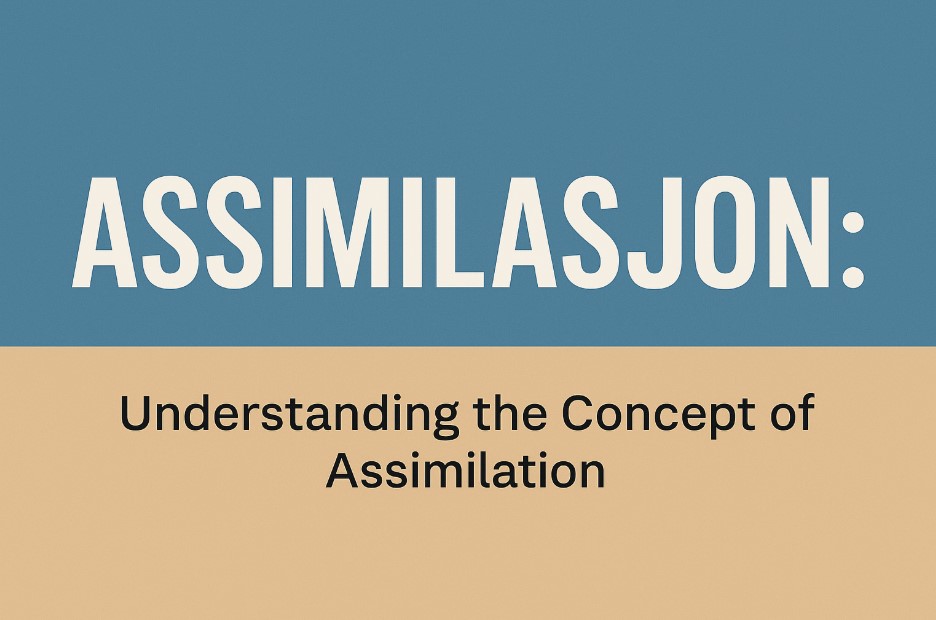Education
Assimilasjon: Understanding the Concept of Assimilation

The word assimilasjon is the Norwegian term for assimilation. It is used in many fields, including culture, language, and biology. Assimilation describes the process by which something becomes similar or blends into something else. In social and cultural contexts, it often refers to how individuals or groups adopt the customs, language, and behaviors of another group. Understanding assimilasjon is important because it helps explain how societies change and how people adapt to new environments. This article explains the meaning of assimilasjon, its types, its effects, and how it appears in different areas of life.
Meaning of Assimilasjon
Assimilasjon means the process of becoming similar to another group or system. In cultural and social studies, it describes how minority groups adopt the culture of a dominant group. In linguistics, it means how a sound becomes more like a neighboring sound in speech. In biology, it refers to the way nutrients are absorbed and used by the body. All these uses have the same basic idea of one thing changing to become part of another.
Cultural Assimilasjon
Cultural assimilasjon happens when people from one cultural background adopt the language, customs, values, and social behaviors of another culture. This often occurs when people move to a new country. They may learn the new language, follow local traditions, and take part in the social life of the new society. Over time, they may become fully integrated into the dominant culture.
This type of assimilasjon can bring both benefits and challenges. It can help people find jobs, education, and social acceptance more easily. However, it can also make them lose parts of their original culture, such as their native language or traditional practices. Some people choose full assimilasjon, while others prefer to keep their cultural identity while still participating in the new society.
Linguistic Assimilasjon
Linguistic assimilasjon refers to changes in speech sounds that make them more similar to nearby sounds. This is common in many languages, including Norwegian. For example, when two consonants come together, one may change to match the other. This process makes words easier and faster to pronounce.
Linguistic assimilasjon is not something speakers usually notice, but it is a natural part of how languages evolve over time. It helps create smoother speech and is an important concept in phonetics and language learning.
Biological Assimilasjon
In biology, assimilasjon means how living organisms absorb nutrients and make them part of their bodies. After food is digested, the nutrients are taken into the cells and used to build new tissues or create energy. This is essential for growth and survival.
Although this meaning is different from cultural or linguistic assimilasjon, it follows the same basic idea of something becoming part of something else. It shows how the term can be used in both social and natural sciences.
Stages of Cultural Assimilasjon
Researchers often describe cultural assimilasjon as happening in stages. At first, newcomers may keep most of their original customs and have limited contact with the new culture. In the next stage, they begin learning the language and adopting some practices from the new society. Later, they may mix both cultures in daily life. In the final stage, they may fully adapt to the new culture and be seen as part of the majority group.
Not everyone goes through all stages, and not everyone wants complete assimilasjon. Some people prefer cultural integration, which means keeping their cultural identity while also participating in the larger society. This shows that assimilasjon is not the same for everyone.
Factors That Influence Assimilasjon
Many factors affect how quickly or how much assimilasjon happens. Language learning is one of the most important. People who speak the majority language often find it easier to take part in education and work. Social support also matters. If people have friends or family in the new culture, they may feel more comfortable adopting new customs.
Government policies can play a role as well. Some countries encourage assimilasjon through education and language programs, while others focus on multiculturalism and allow different cultural groups to maintain their traditions. Personal choice is also important because some people want to blend in fully, while others want to preserve their cultural heritage.
Effects of Assimilasjon
Assimilasjon can have positive and negative effects. On the positive side, it can help people access opportunities, build relationships, and feel included in society. It can also reduce social conflicts by creating shared customs and values.
On the negative side, it can cause the loss of languages, traditions, and cultural diversity. People who go through rapid assimilasjon may feel disconnected from their cultural roots or experience identity conflicts. For societies, too much focus on assimilasjon can lead to pressure on minority groups to give up their culture.
The Heartumental approach to social understanding suggests that balanced assimilasjon is more sustainable. It means adopting useful aspects of the new culture while still valuing and respecting one’s original background. This helps create a more inclusive society.
Assimilasjon vs Integration
Assimilasjon is often compared to integration. While assimilasjon means fully adopting another culture, integration means participating in the larger society while keeping one’s own culture. In integration, people can be part of the community without losing their identity. Many modern societies support integration more than full assimilasjon because it encourages diversity.
Understanding this difference is important because it helps explain debates about immigration and cultural policies. It also shows that people can adapt in different ways, and there is no single correct path.
Conclusion
Assimilasjon is the Norwegian word for assimilation, and it describes the process of becoming part of another group or system. It can refer to cultural, linguistic, or biological changes. Cultural assimilasjon helps explain how people adapt to new environments, while linguistic and biological assimilasjon show how the term is used in other fields. The process can bring opportunities and challenges, and it is influenced by language, social support, policies, and personal choice. While assimilasjon can help people feel included, it can also lead to the loss of cultural identity if done too quickly or completely. Understanding assimilasjon helps people see how cultures change and how individuals find their place in new societies.
-

 Social Media2 months ago
Social Media2 months agoWhat the “67” TikTok Meme Really Means
-

 Tech2 months ago
Tech2 months agoWhat To Do When Your Business Faces Network Vulnerabilities
-

 Self Improvement2 months ago
Self Improvement2 months agoUsing BCBS Rehab to Access Quality Addiction Care
-

 Games2 months ago
Games2 months agoPusoy Strategies for Play That Also Work in Pusoy Dos in English






